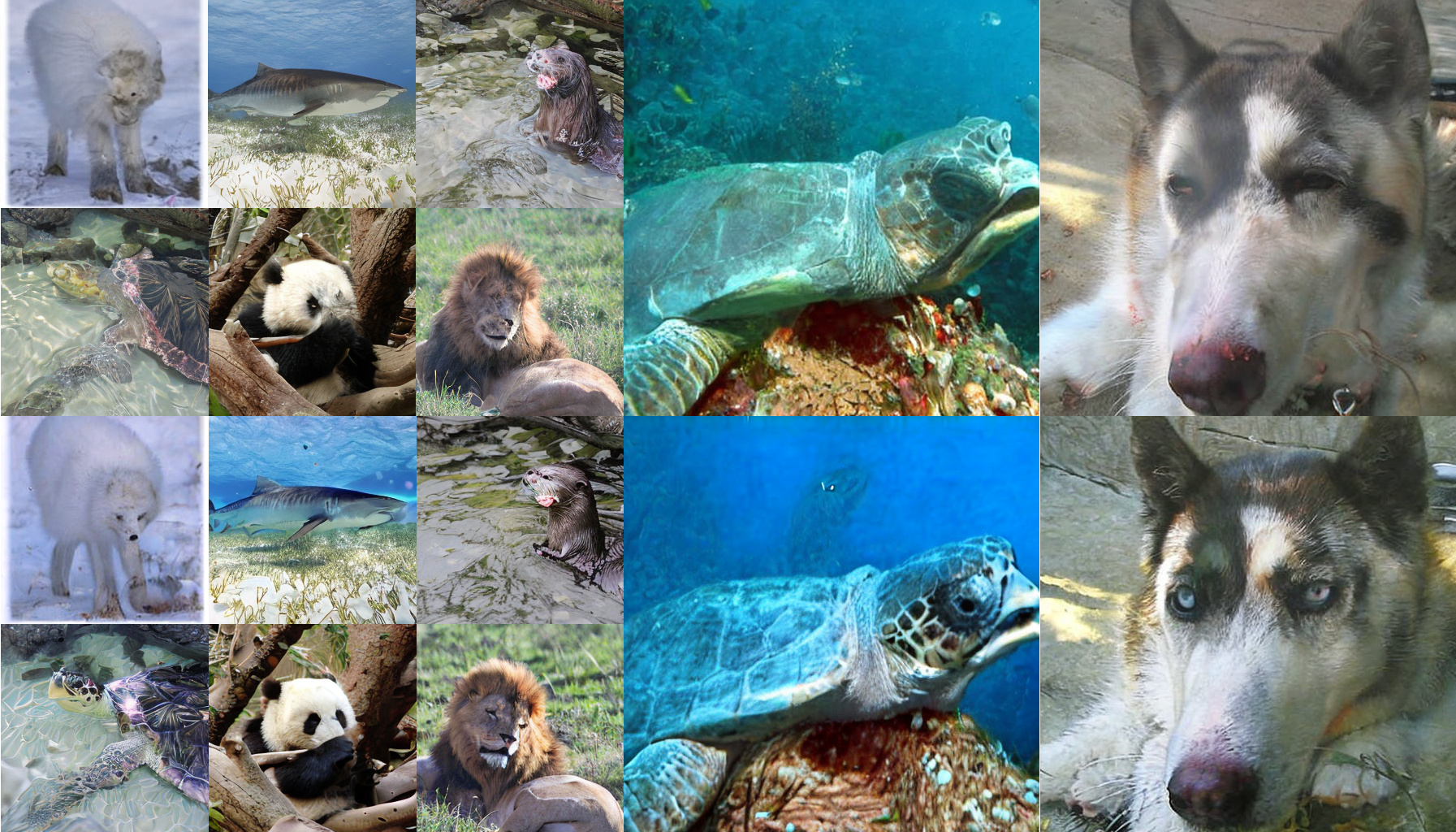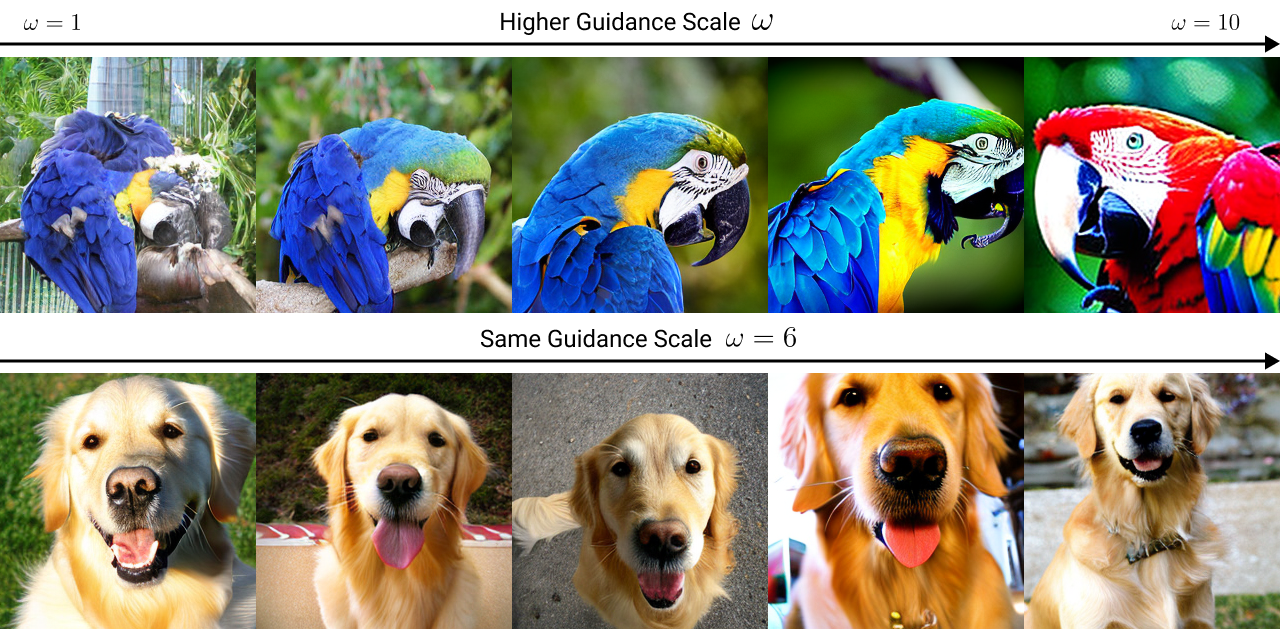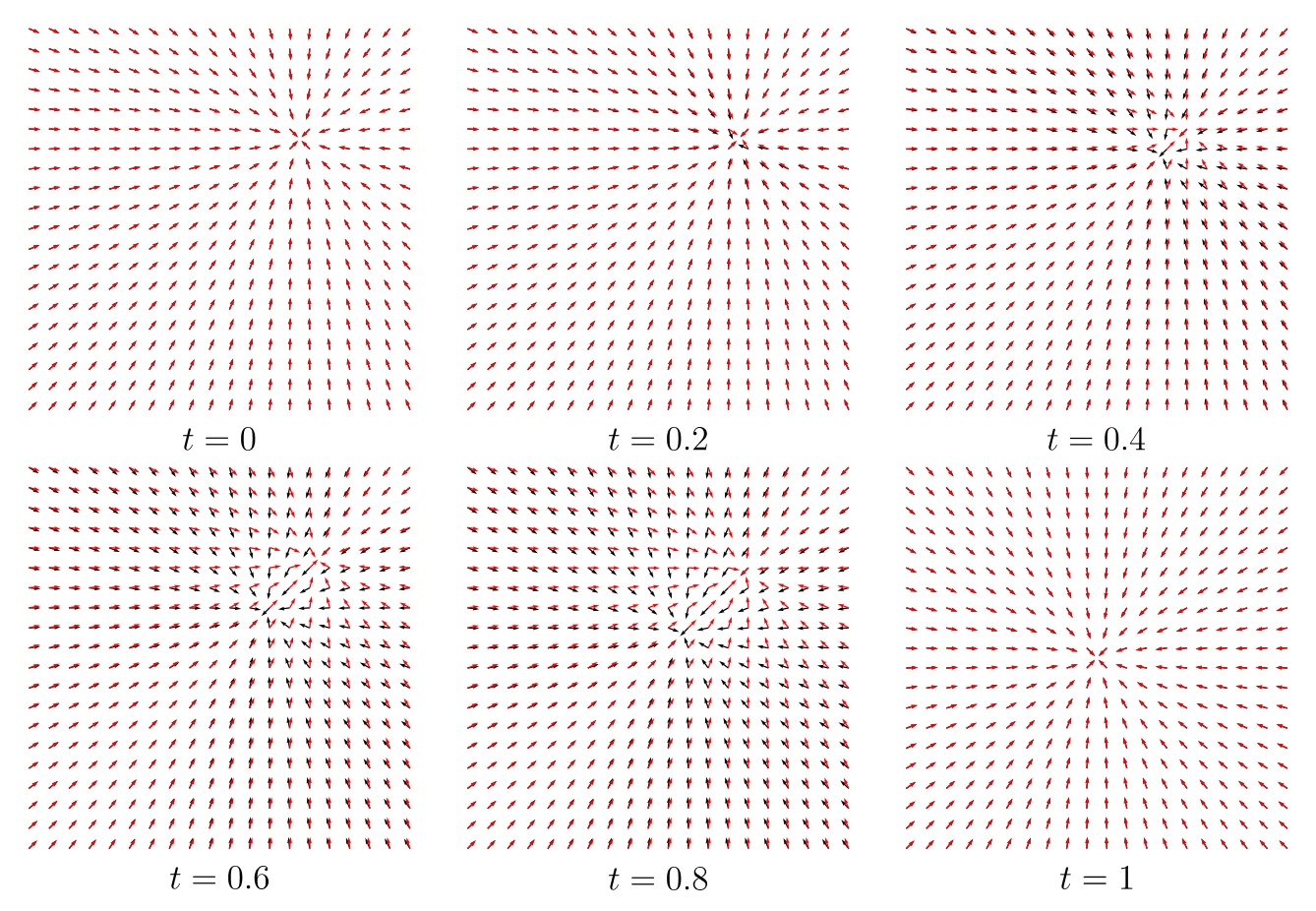Correcting Classifier-Free Guidance for Diffusion Models
This work analyzes the fundamental flaw of classifier-free guidance in diffusion models and proposes PostCFG as an alternative, enabling exact sampling and image editing.
NOTE
This work was done as the final project for MIT 6.7960 Deep Learning Course in Fall 2024.
Classifier-free guidance (CFG) is widely used in diffusion models to improve sample quality and alignment with conditions like class labels and text prompts. Despite its benefits, using high guidance scales can lead to problems such as over-saturation, mode dropping, and lack of diversity. This work identifies a fundamental flaw in CFG that causes these problems. We show that CFG’s sampling process is theoretically flawed, even for simple Gaussian distributions, and provide an empirical analysis of how this affects generated samples. Based on this, we propose PostCFG, a novel guidance method that post-processes the samples via Langevin dynamics. Our results on toy Gaussian distributions demonstrate that PostCFG correctly samples from the target distribution, effectively resolving CFG’s issues. Additionally, ImageNet 512x512 and 256x256 experiments show that PostCFG edits samples to better align with conditions, improving sample quality.

Introduction
Diffusion models have emerged as a highly expressive and scalable class of generative models, showing remarkable performance on image
In this work, we aim to identify the fundamental cause of these issues in CFG. In particular, we theoretically show that CFG’s sampling process converges to a totally different distribution than the target conditional distribution, even for simple Gaussian distributions. Through empirical analysis, we observe that CFG makes notable errors in sampling at intermediate time steps, leading to highly concentrated samples that lack diversity. Based on these findings, we propose PostCFG that instead post-processes the generated conditional samples via Langevin dynamics. Unlike CFG, PostCFG is guaranteed to sample from the sharpened conditional distribution. Our experiments on toy Gaussian distributions demonstrate PostCFG’s effectiveness in correcting CFG’s issues, converging to the target distribution. Finally, we show that PostCFG successfully edits generated images from ImageNet at 512x512 and 256x256 resolutions, leading to better quality and alignment while maintaining diversity.

Background
Diffusion Models
Diffusion Models
Sampling from the data distribution $p_0(\mathbf{x})$ is achieved by solving either the corresponding reverse SDE (Eq. \ref{eq:reverse-sde}) or the probability flow ordinary differential equation (ODE, Eq. \ref{eq:ode})
\begin{equation} \label{eq:reverse-sde} d\mathbf{x} = [\mathbf{f}(\mathbf{x}, t) - \nabla_\mathbf{x} \log p_t(\mathbf{x})]dt + g(t)d\mathbf{w} \end{equation}
\begin{equation} \label{eq:ode} d\mathbf{x} = \left[\mathbf{f}(\mathbf{x}, t) - \frac{1}{2}g(t)^2 \nabla_\mathbf{x} \log p_t(\mathbf{x})\right]dt \end{equation}
Notably, both equations require the score function $\nabla_\mathbf{x} \log p_t(\mathbf{x})$ for every time step $t$, thus a diffusion model is typically trained to estimate this score function or its different parameterization
Classifier-Free Guidance
Classifier-free guidance (CFG) is introduced by Ho & Salimans
Langevin Dynamics
Langevin dynamics enables sampling from a data distribution $p(\mathbf{x})$ using only its score function $\nabla_\mathbf{x} \log p(\mathbf{x})$. Given an initial sample $\mathbf{x} \sim q(\mathbf{x})$ (arbitrary distribution), and a step size $\epsilon$, Langevin dynamics iteratively updates the sample following:
\begin{equation} \label{eq:langevin} \mathbf{x_t} = \mathbf{x_{t-1}} + \frac{\epsilon}{2} \nabla_\mathbf{x} \log p(\mathbf{x_{t-1}}) + \sqrt{\epsilon} \mathbf{w}_t \end{equation} where $\mathbf{w_t} \sim \mathcal{N}(\mathbf{0}, \mathbf{I})$. When $\epsilon \rightarrow 0$ and $T \rightarrow \infty$, Langevin dynamics converges to the target distribution $p(\mathbf{x})$, i.e. $x_T \sim p(\mathbf{x})$. Given a score model $\mathbf{s}_\mathbf{\theta}(\mathbf{x}) \approx \nabla_\mathbf{x} \log p(\mathbf{x})$, Langevin dynamics can be implemented by simply replacing the score function in Eq. \ref{eq:langevin}.
Why is Classifier-Free Guidance Flawed?
Theoretical Analysis
In this section, we revisit the common misconception that CFG approximately samples from the sharpened conditional distribution $p^{\omega}(\mathbf{x} | \mathbf{c})$. Let $p^{\omega}_t(\mathbf{x} | \mathbf{c})$ be a marginal distribution at time step $t$ diffused from the sharpened conditional distribution $p^{\omega}(\mathbf{x} | \mathbf{c})=p^{\omega}_0(\mathbf{x} | \mathbf{c})$ following the forward SDE in Eq. \ref{eq:sde}. To sample from $p^{\omega}$, we need to solve either the reverse SDE or ODE with the score function $\nabla_\mathbf{x} \log p^{\omega}_t(\mathbf{x} | \mathbf{c})$. In CFG, this is replaced by the following: \begin{equation} \label{eq:cfg-score} \mathbf{s}_\mathbf{\theta}^{\omega}(\mathbf{x}, t, \mathbf{c}) \approx \nabla_\mathbf{x} \log p_t(\mathbf{x}) + \omega\cdot(\nabla_\mathbf{x} \log p_t(\mathbf{x} | \mathbf{c}) - \nabla_\mathbf{x} \log p_t(\mathbf{x})) \end{equation}
This is the correct replacement for $t=0$ because $p_0^{\omega}(\mathbf{x} | \mathbf{c}) = p_0(\mathbf{x}) \cdot \left(\frac{p_0(\mathbf{x} | \mathbf{c})}{p_0(\mathbf{x})}\right)^{\omega}$ and
$\nabla_\mathbf{x} \log \left[p_0(\mathbf{x}) \cdot \left(\frac{p_0(\mathbf{x} | \mathbf{c})}{p_0(\mathbf{x})}\right)^\omega\right] = \nabla_\mathbf{x} \log p_0(\mathbf{x}) + \omega\cdot(\nabla_\mathbf{x} \log p_0(\mathbf{x} | \mathbf{c}) - \nabla_\mathbf{x} \log p_0(\mathbf{x}))$, assuming that the score model is well-trained. However, this is not the case for $t>0$ because in general, $ p_t^{\omega}(\mathbf{x} | \mathbf{c}) \propto p_t(\mathbf{x}) \cdot \left(\frac{p_t(\mathbf{x} | \mathbf{c})}{p_t(\mathbf{x})}\right)^{\omega} $ does not hold and thus,
\[\nabla_\mathbf{x} \log p_t^{\omega}(\mathbf{x} | \mathbf{c}) \neq \nabla_\mathbf{x} \log p_t(\mathbf{x}) + \omega\cdot(\nabla_\mathbf{x} \log p_t(\mathbf{x} | \mathbf{c}) - \nabla_\mathbf{x} \log p_t(\mathbf{x}))\]In fact, this flaw has been acknowledged in previous works
Why Gaussian Distributions?
To conduct an analysis without making any approximations, we want all distributions and their score functions to be tractable. When conditional and unconditional distributions $p(\cdot | \mathbf{c})$ and $p(\cdot)$ are Gaussian, their noisy versions are also Gaussian, and additionally (noisy) sharpened conditional distributions $p^{\omega}_t(\cdot | \mathbf{c})$ are also Gaussian. Since the score function of a Gaussian distribution is easily computable (linear), all score functions become tractable.
Let $p(\mathbf{x}) = \mathcal{N}(\mathbf{\mu}, \mathbf{\Sigma})$ and $p(\mathbf{x} | \mathbf{c}) = \mathcal{N}(\mathbf{\mu}_c, \mathbf{\Sigma_c})$. For mathematical simplicity
and the sharpened conditional distribution is $p_t^{\omega}(\mathbf{x} | \mathbf{c}) = \mathcal{N}(\mathbf{\mu}_\omega, \mathbf{\Sigma}_\omega)$ where the following holds:
\[\mathbf{\Sigma_\omega}^{-1} = \omega \mathbf{\Sigma_c}^{-1} + (1-\omega) \mathbf{\Sigma}^{-1}\] \[\mathbf{\Sigma_\omega}^{-1}\mathbf{\mu}_\omega = \omega \mathbf{\Sigma_c}^{-1}\mathbf{\mu}_c + (1-\omega) \mathbf{\Sigma}^{-1}\mathbf{\mu}\]At time step $t$, the diffused version of the sharpened conditional distribution is given by:
\[p_t^{\omega}(\mathbf{x} | \mathbf{c}) = \mathcal{N}(\alpha_t \mathbf{\mu}_\omega, \alpha_t^2 \mathbf{\Sigma_\omega} + \sigma_t^2 \mathbf{I})\]Now, let’s see what happens when sampling with CFG. CFG’s score function in Eq. \ref{eq:cfg-score} corresponds to a score function of the following distribution:
\[\tilde{p}_t^{\omega}(\mathbf{x} | \mathbf{c}) \propto p_t(\mathbf{x}) \cdot \left(\frac{p_t(\mathbf{x} | \mathbf{c})}{p_t(\mathbf{x})}\right)^{\omega}\]and thus, $\tilde{p}_t^{\omega}(\mathbf{x} | \mathbf{c}) = \mathcal{N}(\alpha_t \tilde{\mathbf{\mu}}_\omega, \alpha_t^2 \tilde{\mathbf{\Sigma}}_\omega + \sigma_t^2 \mathbf{I})$ where:
\[\left(\tilde{\mathbf{\Sigma}}_\omega + \frac{\sigma_t^2}{\alpha_t^2} \mathbf{I}\right)^{-1} = \omega \left(\mathbf{\Sigma}_c + \frac{\sigma_t^2}{\alpha_t^2} \mathbf{I}\right)^{-1} + (1-\omega) \left(\mathbf{\Sigma} + \frac{\sigma_t^2}{\alpha_t^2} \mathbf{I}\right)^{-1}\] \[\left(\tilde{\mathbf{\Sigma}}_\omega + \frac{\sigma_t^2}{\alpha_t^2} \mathbf{I}\right)^{-1} \tilde{\mathbf{\mu}}_\omega = \omega \left(\mathbf{\Sigma}_c + \frac{\sigma_t^2}{\alpha_t^2} \mathbf{I}\right)^{-1} \mathbf{\mu}_c + (1-\omega) \left(\mathbf{\Sigma} + \frac{\sigma_t^2}{\alpha_t^2} \mathbf{I}\right)^{-1} \mathbf{\mu}\]CFG’s sampling process is exact if and only if $\tilde{p}_t = p_t^{\omega}$ for all $t \in [0, T]$. Given that $\tilde{p}_t = p_t^{\omega}$ is equivalent to $\tilde{\mathbf{\mu}}_\omega = \mathbf{\mu}_\omega$ and $\tilde{\mathbf{\Sigma}}_\omega = \mathbf{\Sigma}_\omega$ (try comparing the two equations above!), due to the non-linearity of the inverse operation, this holds only for the two end points: $t=0$ ($\alpha_t=1, \sigma_t=0$) and $t=T$ ($\alpha_t=0, \sigma_t=1$). This indicates that CFG’s sampling process is theoretically flawed for all intermediate time steps, even for simple Gaussian distributions. The update rule using Eq. \ref{eq:cfg-score} deviates from the solution of underlying reverse SDE or ODE, thereby leading to a different distribution.
Empirical Analysis
To further analyze the CFG’s sampling process, we present the result of a toy experiment on simple 2D Gaussian distributions in Fig. 3, where $p(\mathbf{x}) = \mathcal{N}((0, 0), \mathbf{I})$ and $p(\mathbf{x} | \mathbf{c}) = \mathcal{N}((0.5, 0.5), 0.5\mathbf{I})$, and $\omega = 6$. As shown in Fig. 4, CFG’s score functions differ from the desired score functions, especially for mid-noise levels ($t = 0.4, 0.6, 0.8$). The result of this error is evident in the generated samples in Fig. 5, where the samples generated by CFG largely deviate from the ground truth samples. Notably, while both DDPM and DDIM samplers lead to mode shifting and smaller variances, DDIM particularly generates highly concentrated samples, probably due to its deterministic nature. These results explain why CFG with high guidance scale leads to over-saturation (= mode shifting) and lack of diversity (= low variance).



Method: PostCFG
We propose PostCFG, a novel guidance method that post-processes the generated samples from the conditional distribution $p(\mathbf{x} | \mathbf{c})$ to the sharpened conditional distribution $p^{\omega}(\mathbf{x} | \mathbf{c})$ via Langevin dynamics.
\begin{equation} \bar{\mathbf{x}}_\bar{t} \leftarrow \bar{\mathbf{x}}_{\bar{t}-1} + \frac{\epsilon}{2} \mathbf{s}^{\omega(\bar{t})}_\mathbf{\theta}(\bar{\mathbf{x}}_{\bar{t}-1}, 0, \mathbf{c}) + \sqrt{\epsilon} \mathbf{w}_t \text{ for } \bar{t} \in [1, \ldots, \bar{T}] \end{equation}
where $\mathbf{s}^{\omega(\bar{t})}_\mathbf{\theta}(\mathbf{x}, 0, \mathbf{c})$ is the CFG’s score estimate in Eq. \ref{eq:cfg} for time step $t = 0$, $\mathbf{w}_t \sim \mathcal{N}(\mathbf{0}, \mathbf{I})$, $\epsilon$ is the step size, and $\bar{T}$ is the number of Langevin steps. The Langevin dynamics starts from $\bar{\mathbf{x}}_0 = \mathbf{x}_0 \sim p(\mathbf{x} | \mathbf{c})$ sampled from the conditional distribution using the diffusion model.
Consider a case where $\omega(\bar{t}) = \omega$ for every $\bar{t}$. Then, $\mathbf{s}^{\omega(\bar{t})}_\mathbf{\theta}(\mathbf{x}, 0, \mathbf{c})$ correctly estimates the score function of $p^{\omega}(\mathbf{x} | \mathbf{c})$, and thus, the Langevin dynamics converges to the target distribution $p^{\omega}$ if $\epsilon \rightarrow 0$ and $\bar{T} \rightarrow \infty$. This guarantees that PostCFG correctly samples from the sharpened conditional distribution $p^{\omega}(\mathbf{x} | \mathbf{c})$. In practice, we give a linear dynamic schedule for $\omega(\bar{t})$ following:
\begin{equation} \omega(\bar{t}) = \frac{\bar{t}}{\bar{T}} \cdot \omega \end{equation}
The intuition behind this is that Langevin dynamics suffers from slow mixing when sampling from a multimodal distribution
Experiments
Revisiting Gaussian
We first revisit the toy experiment on simple 2D Gaussian distributions to demonstrate PostCFG’s effectiveness in correcting CFG’s issues. As shown in Fig. 6, PostCFG successfully generates samples that align with the ground truth samples with 50 Langevin steps. We additionally present a quantitative comparison in Tab. 1, showing that PostCFG significantly outperforms CFG in terms of FID

| Method | Exact (DDIM) | Exact (DDPM) | CFG (DDIM) | CFG (DDPM) | PostCFG (Ours) |
|---|---|---|---|---|---|
| FID ($\downarrow$) | 0.0003 | 0.0013 | 0.1131 | 0.0180 | 0.0005 |
Image Synthesis
We generate samples from ImageNet at 512x512 and 256x256 resolutions using DiT-XL/2
PostCFG enables realistic editing $\;$ Fig. 1 presents the editing capability of PostCFG on class-conditional ImageNet samples. We observe that PostCFG edits the generated images in a realistic manner (e.g. more detailed faces and fur), leading to improved quality and better alignment with class labels. Notably, PostCFG minimally changes the original samples, and thus, in practice, one can use PostCFG to correct the generated images without losing the original style.
PostCFG generates diverse samples $\;$ As shown in Fig. 7, when using a high guidance scale, CFG generates samples that are similar to each other, lacking diversity. In contrast, PostCFG generates more diverse samples. This can be explained in two ways: 1) CFG samples from a distribution that is more concentrated than the sharpened conditional distribution (e.g. Fig. 5), and 2) PostCFG starts from the conditional distribution and only slightly modifies the samples, thereby maintaining diversity.

PostCFG reduces over-saturation $\;$ Fig. 8 demonstrates that PostCFG effectively resolves over-saturation in CFG when using high guidance scales. As the guidance scale increases, samples generated by CFG become significantly over-saturated, while PostCFG smoothly gains more details without over-saturation. This can be attributed to the fact that PostCFG samples from the sharpened conditional distribution, whereas CFG samples from another skewed distribution.

Limitations
Our work has several limitations. PostCFG often fails to generate realistic samples when the original samples have poor quality, as shown in Fig. 9. This can be attributed to two factors: 1) PostCFG can only modify high-frequency details as Langevin dynamics starts from a clean image. While theoretically Langevin dynamics is independent of the initial distribution, in practice, very many steps are required to modify the low-frequency details. 2) CFG’s superior quality is not solely due to going towards the sharpened conditional distribution. As

Conclusion
We have introduced PostCFG, a guidance method that corrects the fundamental flaw of classifier-free guidance, allowing for exact sampling from the sharpened conditional distribution. PostCFG effectively resolves issues associated with classifier-free guidance, such as over-saturation and limited diversity. Additionally, it brings new post-editing capabilities to diffusion models, which can be leveraged to improve the quality and condition alignment of samples.